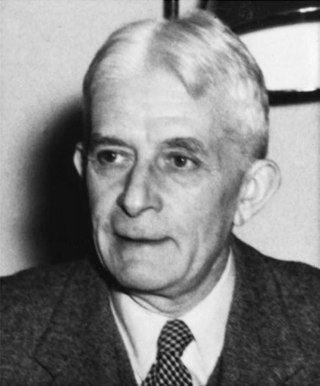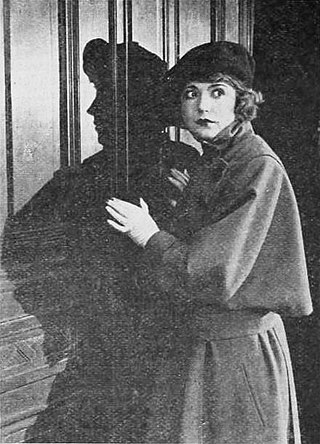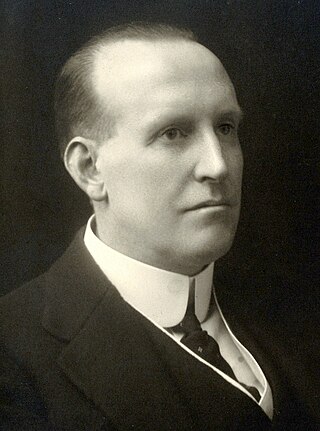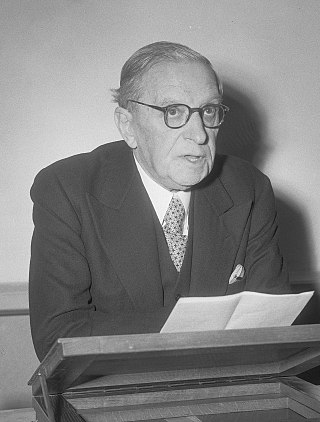Related Research Articles
Gestalt psychology, gestaltism, or configurationism is a school of psychology and a theory of perception that emphasises the processing of entire patterns and configurations, and not merely individual components. It emerged in the early twentieth century in Austria and Germany as a rejection of basic principles of Wilhelm Wundt's and Edward Titchener's elementalist and structuralist psychology.

Max Wertheimer was a psychologist who was one of the three founders of Gestalt psychology, along with Kurt Koffka and Wolfgang Köhler. He is known for his book, Productive Thinking, and for conceiving the phi phenomenon as part of his work in Gestalt psychology.

Wolfgang Köhler was a German psychologist and phenomenologist who, like Max Wertheimer and Kurt Koffka, contributed to the creation of Gestalt psychology.
The Von Restorff effect, also known as the "isolation effect", predicts that when multiple homogeneous stimuli are presented, the stimulus that differs from the rest is more likely to be remembered. The theory was coined by German psychiatrist and pediatrician Hedwig von Restorff (1906–1962), who, in her 1933 study, found that when participants were presented with a list of categorically similar items with one distinctive, isolated item on the list, memory for the item was improved.

Kurt Lewin was a German-American psychologist, known as one of the modern pioneers of social, organizational, and applied psychology in the United States. During his professional career Lewin applied himself to three general topics: applied research, action research, and group communication.

The Ehrenstein illusion is an optical illusion of brightness or colour perception. The visual phenomena was studied by the German psychologist Walter H. Ehrenstein (1899–1961) who originally wanted to modify the theory behind the Hermann grid illusion. In the discovery of the optical illusion, Ehrenstein found that grating patterns of straight lines that stop at a certain point appear to have a brighter centre, compared to the background.
Ulric Richard Gustav Neisser (December 8, 1928 – February 17, 2012) was a German-American psychologist, Cornell University professor, and member of the US National Academy of Sciences. He has been referred to as the "father of cognitive psychology". Neisser researched and wrote about perception and memory. He posited that a person's mental processes could be measured and subsequently analyzed. In 1967, Neisser published Cognitive Psychology, which he later said was considered an attack on behaviorist psychological paradigms. Cognitive Psychology brought Neisser instant fame and recognition in the field of psychology. While Cognitive Psychology was considered unconventional, it was Neisser's Cognition and Reality that contained some of his most controversial ideas. A main theme in Cognition and Reality is Neisser's advocacy for experiments on perception occurring in natural settings. Neisser postulated that memory is, largely, reconstructed and not a snap shot of the moment. Neisser illustrated this during one of his highly publicized studies on people's memories of the Challenger explosion. In his later career, he summed up current research on human intelligence and edited the first major scholarly monograph on the Flynn effect. A Review of General Psychology survey, published in 2002, ranked Neisser as the 32nd most cited psychologist of the 20th century.
DISC assessments are behavioral self-assessment tools based on psychologist William Moulton Marston's DISC emotional and behavioral theory, first published in 1928. These assessments aim to predict job performance by categorizing individuals into four personality traits: dominance, inducement, submission, and compliance.

Suspense is a state of anxiety or excitement caused by mysteriousness, uncertainty, doubt, or undecidedness. In a narrative work, suspense is the audience's excited anticipation about the plot or conflict, particularly as it affects a character for whom the audience feels sympathy. However, suspense is not exclusive to narratives.

Bluma Zeigarnik was a Soviet psychologist of Lithuanian origin, a member of the Berlin School of experimental psychology and the so-called Vygotsky Circle. She contributed to the establishment of experimental psychopathology as a separate discipline in the Soviet Union in the post-World War II period.
Karl Duncker was a German Gestalt psychologist. He attended Friedrich-Wilhelms-University from 1923 to 1923, and spent 1925–1926 at Clark University in Worcester, MA as a visiting professor, where he received a master's degree in arts degree. Until 1935 he was a student and assistant of the founders of Gestalt psychology in Berlin: Max Wertheimer, Wolfgang Köhler and Kurt Koffka. In 1935, exiled by the Nazis, he got an assistantship in Cambridge with Frederic Charles Bartlett and later immigrated to the US, where he was again an assistant of Wolfgang Köhler's at Swarthmore College. Duncker committed suicide in 1940 at 37 years of age. He suffered from depression for some time and had received professional treatment.
In topological and vector psychology, field theory is a psychological theory that examines patterns of interaction between the individual and the total field, or environment. The concept first made its appearance in psychology with roots in the holistic perspective of Gestalt theories. It was developed by Kurt Lewin, a Gestalt psychologist, in the 1940s.
Interruption science is the interdisciplinary scientific study concerned with how interruptions affect human performance, and the development of interventions to ameliorate the disruption caused by interruptions. Interruption science is a branch of human factors psychology and emerged from human–computer interaction and cognitive psychology.

Francis Graham Crookshank was a British epidemiologist, and a medical and psychological writer, and Fellow of the Royal College of Physicians.
In social psychology, naïve realism is the human tendency to believe that we see the world around us objectively, and that people who disagree with us must be uninformed, irrational, or biased.
The Mentality of Apes by Wolfgang Köhler is a landmark work in ethology, cognitive psychology and the study of the anthropoid apes. In it the author, a leading gestalt psychologist, showed that chimpanzees could solve problems by insight. The importance of this work was to show there is no absolute dividing line between the human species and their nearest living relative, at least in this respect. It was also a marker in the struggle between behaviourism and cognitive psychology which continued for the following half century. Köhler's observations and experiments were done on chimpanzees in captivity. Not until Jane Goodall's work later in the century was the behaviour of chimpanzees in the wild studied in depth.

Géza Révész was a Hungarian-Dutch psychologist of Jewish heritage, and is regarded as one of the pioneers of European psychology.
In psychology, the Ovsiankina effect describes the innate human urge to finish tasks we've initiated. This tendency to resume an interrupted action is especially prevalent when the action hasn't yet been achieved. The effect is named after Maria Ovsiankina, who conducted research on this behavior.
Maria Arsenjevna Rickers-Ovsiankina (1898–1993) was a Russian-German-American psychologist. She studied what is now known as the Ovsiankina effect, a variation of the Zeigarnik effect. Ovsiankina worked in a variety of psychology jobs, including working with schizophrenia patients. She wrote books about psychological testing.
References
- ↑ Koffka, Kurt (1935). Principles of Gestalt Psychology. London: Kegan Paul, Trench, Trubner & Co. p. 334ff. ISBN 978-0-415-86881-5. OCLC 2314654.
- ↑ Ovsiankina, Maria (January 1928). "Die Wiederaufnahme unterbrochener Handlungen" [Resumption of Interrupted Tasks]. Psychologische Forschung (in German). 11 (3/4): 302–379. doi:10.1007/BF00410261. S2CID 147359058. Archived from the original on 2022-02-26.
- ↑ Zeigarnik, Bluma (1938). "Das Behalten erledigter und unerledigter Handlungen" [On Finished and Unfinished Tasks](PDF). Psychologische Forschung (in German). 9: 1–85. Archived (PDF) from the original on 24 December 2021. pp. 300-314 in W. D. Ellis (Ed.), A Sourcebook of Gestalt Psychology, London: Kegan Paul, Trench, Trubner & Co.
- 1 2 Lewin, Kurt (1935). A Dynamic Theory of Personality: Selected Papers. McGraw-Hill Book Company, Inc. p. 243ff. ISBN 978-0-07-037451-5. OCLC 760465262.
- ↑ Zeigarnik, Bluma (1927). "Das Behalten erledigter und unerledigter Handlungen" [Remembering completed and uncompleted actions](PDF) (in German). pp. 300–314. Archived (PDF) from the original on 24 December 2021.
- ↑ McKinney, Fred (April 1935). "Studies in the Retention of Interrupted Learning Activities". Journal of Comparative Psychology . 19 (2): 265–296. CiteSeerX 10.1.1.66.8781 . doi:10.1037/h0056005. Archived from the original on 5 May 2019.
- ↑ Moore, Matt (4 October 2017). "How the NBA's newly imposed 'Harden Rule' will impact James Harden this season". CBSSports.com. Archived from the original on 6 February 2020. Retrieved 21 April 2020.
- ↑ Boone, Kyle (September 22, 2017). "The NBA is finally cracking down on James Harden's foul-drawing antics". CBSSports.com. Archived from the original on October 5, 2017. Retrieved October 4, 2017.
- ↑ "NBA implementing 'Zaza Pachulia,' 'James Harden' rules". NBCSports.com. September 21, 2017. Archived from the original on October 4, 2017. Retrieved October 4, 2017.
- ↑ Einstein, Gilles O.; McDaniel, Mark A.; Williford, Carrie L.; Pagan, Jason L.; Dismukes, R. Key (2003). "Forgetting of intentions in demanding situations is rapid" (PDF). Journal of Experimental Psychology: Applied . 9 (3): 147–162. CiteSeerX 10.1.1.5.4816 . doi:10.1037/1076-898X.9.3.147. PMID 14570509. Archived from the original (PDF) on 2016-03-04.
[...] there is controversy regarding the reliability of the Zeigarnik effect [...]
- ↑ Colin M. MacLeod (6 April 2020). "Zeigarnik and von Restorff: The memory effects and the stories behind them". Memory and Cognition. doi:10.3758/S13421-020-01033-5. ISSN 0090-502X. PMID 32291585. Wikidata Q91935831.